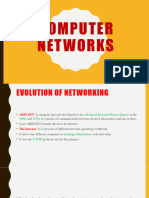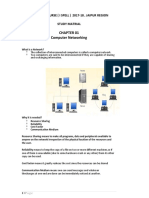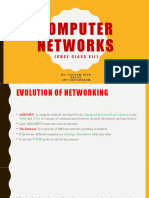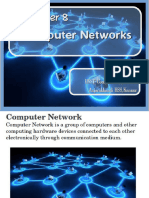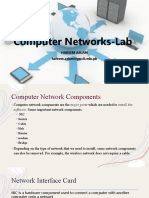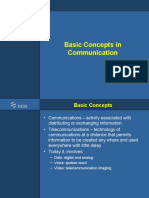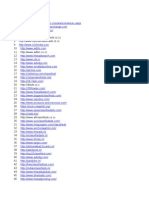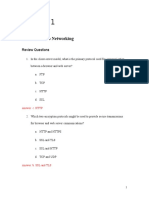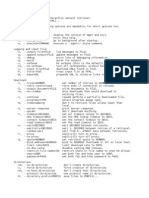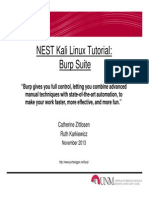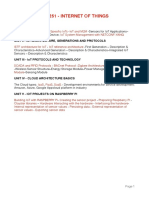CHAPTER 8
COMPUTER
NETWORKS
Prepared by TCA Gafoor
For AKM HSS Kottoor
Download these slides from
http://akmhsskottoor.webs.com
Whatsapp 9847995577
�Computer Networks
A
computer network is a
collection of autonomous
geographically distributed
computers
They inter connected
together
To enable meaningful
transmission and exchange of
information among them.
�Advantages of
Networks
Resource
sharing: - It can exchange
entrally
stored information all
over the world.
Reliability: - The information exchanged
through the network will be
reliable.
Economy: - Can exchange information
with
low cost.
Security, Scalability, Communication,
Remote database accessing.
�Key Terms
Bandwidth:The
amount of data
that can be send over a
connection in a given time
Noise:unwanted electrical signals
that reduces the quality of data
signals
Node: - An individual computer or
device connected in to a network
is called workstation or node or
client.
�Data Communication System
The
process in which sending da
electronically over a long
distance.
It involves 3 basic elements:
Source (Sender)
Destination (Receiver)
Communication medium
Communication
Source
Destination
Medium
�Basic Elements
Source:- A source is a system
or device or person that
produces message for sending.
Destination:- A system or
device or person that receives
message is called destination.
Communication medium:- They
are used to transmit message
from source to destination.
Protocol: Rules for Data
transmission
�Communication Media
Guided Media(Bounded)
Un Guided Media(Un Bounded)
Twisted Pair Wire
Electro magnetic signals are
transmitted through air,
vacuum or water
Micro Wave Infrared
Coaxial Cable
Satellite
Wi-fi
Optical Fibre
Radio
Waves
Wi-Max
Electro magnetic signals
are transmitted along a
closed physical path
Bluetooth
�Twisted Pair Wire
It consists of two insulated copper wires, twisted together in a helical
form(DNA model) typically used in telephone system.
It can use several kilometers without amplification.
For more distances repeaters are needed
Twisted pair cable have more than one twisted pair wires. They are
Unshielded Twisted pair cable(UTP)
Shielded Twisted pair cable(STP)
�UTP Cable
A
set of twisted pair wires in
a single plastic encasement.
Commonly used in telephone
system.
Low cost and easy to install.
Carry both data and voice.
�STP Cable
A
set of twisted pair wires
wrapped in a foil shielding
(Metal shield).
High cost and difficult to install
than UTP.
Carry both data and voice.
Metal shield avoids cross talk.
�Twisted pair wire
�Coaxial Cables(Coax)
It consists of a central copper wire , surrounded by an insulating
material.
The insulator is encased by a cylindrical conductor, it is covered
In a protective sheath
Used in long distance Telephone system, Cable TV,Networks.
For long distance at higher speed
Two types of Coax are there. They are
Base band Coax
Broad band Coax
�Base band & Broad band Coax
Base band Coax
Transmit a single
signal at a time at
high speed.
Commonly
used in
digital
transmission.
Broad band Coax
Transmit many
simultaneous
signals in
different
frequencies.
Commonly used in
analog
transmission
�Coaxial Cables(Coax)
�Fiber Optics
Similar to coaxial cable ,at the center there is a glass core through
Which the light propagates.
A cladding is used to keep all the light in the core
To protect the cladding a outer plastic jacket is used
They are reliable for transmitting huge amount of digital data
at high speed without errors.
Adv.& Dis. adv:- High bandwidth, Noise resistance, High
signal carrying capacity. But High cost,maintenance is too
expensive, Difficult to install and fragility,
�Fiber optics
PROTECTING SHEATH
CLADDING
THIN GLASS
CORE
�Microwaves
They are high frequency radio waves. They travel in free
air in straight line.Can transmit data signals up to 40 miles
with high band width.
To transmit signals parabolic antennas are used.For long
distance communication repeaters are used.Repeater
includes a transceiver. (Transmitter + Receiver)
Used in long distance telephone communication and
cellular communication
�Microwaves
�Radio Waves
They
propagate surface waves
for long distance
communication. They have
different frequencies from
VLF LF MF HF VHF UHF SHF EHF
3KHz-300GHz
3KHZ 30KHZ 300KHZ 3MHZ 30MHZ 300MHZ 3GHZ 30GHZ 300GHZ
USAGES
Submarine, Long range navigation, AM radio,
International broadcasting, Military,Telegraph,
VHF television, Mobile phone, Radar, FM radio,
Aircraft Communications etc..
�Infrared waves
IR
waves have a frequency range
of 300Ghz to 400THz.used for short
range communication. Eg: Remote
control, cordless mouse etc
Characteristics:
1. Line of sight transmission
2. Only two device at a time
3.Longer distnance, weak
performance
4.Can not cross through solid
�Bluetooth
Bluetooth
waves uses radio
Waves with a frequency range of
2.402 Ghz to 2.48 GHz.used for
short range communication. Used
in Cellpohone,
Laptop,Mouse,Keyboard
,Tablet,Headset etc
Characteristics:
1. Line of sight is not required
2. Connect upto eight devices
simultaneously
�Wi-Fi
Wireless
uses
Fidelity
radio Waves with a frequency range of 2.4
Ghz to 5 GHz.Used in Cellpohone, Laptop etc.It
can do two way communication.Wireless
adapter produce radio signals and transmits,
Wireless router recievs and decodes it
Characteristics:
1. Line of sight is not required
2. Connect lots of devices simultaneously
3. Data Transfer speed up to 54 Mbps
4. Used for communication up to 375 feet(114
meter)
�Wi-Max
Microwave
It
Access
combines benefits of broadband and wireless
with a frequency range of 2 Ghz to 11 GHz. Provide
High speed Wireless Internet over long distances
(like a city).It has two parts
A Base station installed by ISP and Receiver.
Characteristics:
2. Connect 100s of devices to a station
3. Data Transfer up to 70 Mbps up to 45 Kilometers
4. Line of sight not required
5.High Power consumption & High cost
�Satellites
Used to transmit data from one continent to another
continent with 3-30 GHZ frequency.
Satellites are placed in atmosphere and they revolve the
earth at the same speed of earth. So they are called
geostationary satellite.
Satellite control station send the signals to satellites from
earth and parabolic antennas retransmit it to the
destination.
Transferring signals from earth to satellite is called
Uplink and from satellite to earth is called Downlink.
�Satellites
�Data Communication
Devices
NIC (Network Interface Card)
Hub
Switch
Repeater
Bridge
Router
Gateway
�DataCommunication
Devices
Network
Interface Card (NIC): - It is
used to connect a computer or
other device to a network. It is also
called network adapter. It consists
of electronic circuit to retrieve and
transfer data.(1 Gbps)
�Data Communication
Devices
Network
Interface Card (NIC): - It is
used to connect a computer or
other device to a network. It is also
called network adapter. It consists
of electronic circuit to retrieve and
transfer data.(1 Gbps)
�Hub
This device is used in wired network to connect
computers/devices of the same network
Small ,simple and inexpensive device
Disadvantage is increases the network traffic and
reduces effective bandwidth
�Switch
This device is same like hub but higher performance
to reduce network traffic,used in network to connect
computers/devices of the same network
It sent data to the correct destination by looking the
address of node
�Repeater
This device is used for receiving, amplifying and
transmitting signals in both directions.
It amplifies the weak signals. So the are used in long
distance transmission.
�Bridge
The
device that is used to connect
similar LAN are called bridge.
Here can establish security for data
to avoid unauthenticated using.
LAN 1
Bridge
LAN 2
�Router
The process of determining how a connection is to
be setup is called routing.
Router choose a efficient path for data transfer
from a group of paths.
Also a router joints two networks with different
protocols.
Router
Router
�Gateway
Used
to connect the
dissimilar networks is called
Gateway.
Many
networks exist in world with
different hardware and software. To
inter connect these networks we use
the device Gateway
�Data Terminal Equipment
They
provide the data flow to or
from a computer
They
1.
are
Modem
2. Multiplexer
�Modem
A modem is a device that is used to convert analog
signal to Digital Signal and vice versa.
The word modem come from:
Modulation:-Conversion from digital to analog
Demodulation:-Conversion from analog to Digital
Analog Signal
Modem
Digital Signal
Computer
Modem is used when we gathering information from
internet. Because the data transfer media here is
telephone line. Telephone line carries only Analog signals
and computers works with digital signal
�Multiplexer/Demultiplexer
Multiplexing
is the process in which it
combines more than one signals in to one
signal.
The device used for this called multiplexer.
Multiplexer combines the input from
different sources and load them on a single
channel of a medium
Its reverse process is called Demultiplexing.
A
B
Multiplexer
C
Together to win... 98464 55192
�Network Topologies
It
refers the way of connecting
node in to network to work
together.
They are classified in to six. They
are
1. Bus Topology
2. Star Topology
3. Ring Topology
4. Mesh Topology
�Bus Topology
Server
�Bus Topology
Here
all nodes are connected to a single shared
communication link (Bus).
Advantages
It is simple, reliable and less expensive.
Easy to install and extend.
Less hardware is needed.
Disadvantages
It slows when huge amount of data is transmitted.
Collisions happened.
More connections weaken the signal.
A cable break affects the whole.
Difficult to trouble shoot.
Server
�Star Topology
Server
�Star Topology
Server
Here
nodes are connected to a central
server with different cables.
Advantages
It is a centralized monitoring and network
management.
A cable break does not affect the whole.
Easily to trouble shoot.
Disadvantages
Hub failure affects the network.
More hardware and cabling are needed.
Powerful server is needed.
�Ring Topology
�Ring Topology
Here
each node is connected only two adjacent
nodes only in a circular order.
Here the method token passing is used to
transmitting data.
Advantages
Less cabling is needed.
A particular node transmitted data at a time.
Performance is stable.
Disadvantages
Data is passed through every node.
Trouble shooting is difficult.
Network configuration is difficult.
�Mesh Topology
�Mesh Topology
Here
each and every node is
connected to other nodes.
Any one of the connection is
failed it will not affect the others.
It is expensive because more
cables and adapters are used.
Reconfiguration is difficult.
�Types of Networks
PAN
(Personal Area Network)
LAN (Local Area Network)
WAN (Wide Area Network)
MAN (Metropolitan Area Network)
�PAN (Personal Area Network)
It
is an individual / personal network
within a few meters of distance
Like mobile phone connected to PC
via bluetooth,USB Cable,
Printer connected to PC
Smart phone connected to Personal
Wifi Router
Mobile to mobile connected via
infrared etc
�LAN (Local Area
Network)
They
are privately owned networks with a
geographical coverage of less than a
kilometer.
They are usually setup with in a building or
a campus.
Its speed is 10 MBps to 100MBps.
Here twisted pair cable, coaxial cables,
optical fiber are used as the communication
media.
It has less error rate, less expensive.
Ethernet uses LAN.
�WAN (Wide Area
Network)
It
covers across large geographical
area such as countries and
continents.
Otherwise it interconnects multiple
LANs.
Its speed is 1200Bps to 2MBps. It
has more errors than LAN and
expensive.
Telephone lines, satellite channels
are uses WAN. ARPANET and
�MAN (Metropolitan Area
Network)
It
is usually cover a wider
geographic area about 100 KM in
diameter.
Its speed is nearer to LAN.
They also used to connect LANs.
Coaxial cable is used as
communication media in MAN.
�Internet
Internet
is a very large network of
computers that interconnect many different
networks in different parts of the world.
It is a global network or network of
networks.
So it is a public networks and it is accessible
for everyone.
Here the transmission is done by using
TCP/IP (Transmission Control
Protocol/Internet Protocol).
It provides different services like www, Email, video conferencing, chatting etc.
�Logical classification of network
�I want to
collaborate
with my
colleague
I want to access
some information
Client
Server
Client/server
Peer-to-peer
�Client Server
Client-server
Asymmetric relationship
Client predominately makes requests,
server makes replies
�Categories of Servers
File
Server
Web Server
Print Server
Database Server
�File Server
File
Servers manage a work groups application
and data files, so that they may be shared by the
group.
Very I/O oriented
Pull large amount of data off the storage
subsystem and pass the data over the network
Requires many slots for network connections
and a large-capacity, fast hard disk subsystem.
�Web Server
Performs
request for web pages
Print Server
Performs
print jobs from client
to specific printers
Database Server
Accepts requests for data, retrieves the data fro
its database(or requests data from anoth
node)and passes the results back.
�Network Protocol
Communication
Protocols are set
of rules and standards that allow
different devices to allow
effective communication.
(Human
comm. Language, Grammar,
Cultural rules etc.)
Protocol
defines the following
Syntax
Semantics
Timing
�Protocol Includes.
Syntax
Defines the structure or format of
data to be communicate. (What)
Semantics
Specifies interpretation of data
that is being send. (How)
Timing
Refers the transmission rate and
duration. (When)
�Commonly Used Protocols
IP
(Internet Protocol)
TCP
(Transmission Control
Protocol)
FTP
(File Transfer Protocol)
SMTP
(Simple Mail Transfer
Protocol)
HTTP
(Hyper Text Transfer
Protocol)
POP
(Post Office Protocol)
�Internet Protocol (IP)
It
is a protocol used by the internet
for transferring message from one
system to another.
The messages are send in the form
of packets.
IP supports routing and relaying.
It use in packet format of TCP/IP
reference model
IP address is number combination of
network number and host number to
identify the host computer.
E.g. 164.120.9.61
�Transmission Control Protocol
(TCP)
It
ensure the reliable delivery of data
between hosts.
It collects the packets in proper order.
It use in transport layer of TCP/IP reference
model
�File transfer protocol (FTP)
Used
for transferring files in computer
networks.
It use in application layer of TCP/IP
reference model
It is easier protocol.
Most useful way to sharing information.
�Hypertext Transfer Protocol
(HTTP)
Used
to transfer hypertext documents and
data from one computer to another.
This protocol used to communicate web
server and web client computers.
�DNS(Domain Name
System)
DNS
returns the IP address of the
domain name we requested.
When we type a website address
like www.google.co.in
Our
ISP contact the DNS server
and ask the IP address for the
site,and returns the address and
connect to the page
�Identification of computer over a n/w
MAC
address (12 Digit
,Hexadecimal number assigned to
network interface Card NIC)
media access control
address (MAC address) is a
unique identifier assigned to
network interfaces for
communications on the physical
network segment
Eg: 00:A0:C9 : 14:C8:35
SL No
ID
Number
of NIC
�IP Address
An
Internet Protocol address
(IP address) is a numerical label
assigned to each device (e.g.,
computer, printer) participating
in a computer network that uses
the Internet Protocol for
communication.
IP
addresses are binary numbers, but they
are usually stored in text files and displayed
in human-readable notations, such as
172.16.254.1 (for IPv4), and
2001:db8:0:1234:0:567:8:1 (for IPv6).
�Uniform Resource Locator(URL)
A
uniform resource locator (also
known as a web address, particularly
when used with HTTP) is a specific
character string that constitutes a
reference to a resource. Most web
browsers display the URL of a web page
above the page in an address bar. A
File Name
Domainlook
Name like:
typical URL might
http://www.dhsekerala.org/mainmen
u.htm
�Sub Domain Name
�Country Specific Domain Names
�Thank U all
Prepared by TCA Gafoor
For AKM HSS Kottoor
Download these slides from
http://akmhsskottoor.webs.com
Whatsapp 9847995577





